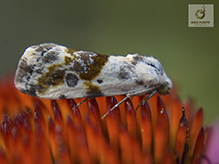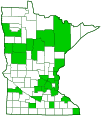Olive-shaded bird-dropping moth
(Ponometia candefacta)
Conservation • Description • Habitat • Ecology • Distribution • Taxonomy
| Hodges # | 9090 |
||
Conservation Status |
|||
| IUCN Red List | not listed |
||
| NatureServe | NNR - Unranked SNR - Unranked |
||
| Minnesota | not listed |
||
Description
Olive-shaded bird-dropping moth is a small owlet moth. It occurs throughout the United States, in southern Canada from Nova Scotia to Manitoba, and in Mexico. It was introduced into southwestern U.S.S.R. in 1969 to control the spread of Ambrosia species. It is now successfully established as far north as Saint Petersburg. In the United States it is common from the East Coast to the Great Plains, less common in the southwest, and mostly absent from the mountain west and Pacific northwest. In Minnesota it is relatively uncommon in most of the state but locally common in some areas (CCESR). Adults are found in old fields, weedy disturbed areas, agricultural fields, and urban areas. Larvae feed on two species of ragweed (Ambrosia spp.), only one of which, western ragweed (Ambrosia psilostachya), occurs in Minnesota. They have been raised on other Ambrosia species in the lab, but apparently do not use those species as hosts in nature.
Adults are long and narrow. They are ½″ (12 mm) in length and have a 11⁄16″ to ⅞″ (18 to 22 mm) wingspan.
The forewings are narrow, rounded at the tip, and white, with gray markings and yellowish mottling. The pattern on the forewing resembles bird droppings. This is the feature that gives the family Acontiinae its common name. The basal and antemedial lines are represented by diffuse, light gray patches near the wing base. The median and postmedial lines are each represented by a dark gray patch on the leading edge (costal margin). Yellowish mottling in the median and subterminal areas appears olive-green or olive-brown when merging with a gray spot. This is the feature that gives the species its common name. The circular spot (orbicular spot) in the upper median area is tiny and black. The usually kidney-shaped spot (reniform spot) in the lower median area on this species is perfectly round and is outlined with white. A gray and olive-gray band begins as a large patch on the inner margin between the median and subterminal lines, extends through the reniform spot, and thins as it approaches the apex. A broad white area with two or three often connected gray spots separate the band from the terminal area. The terminal line consists of a row of dark dashes. The fringe is gray beyond the discal cell, at the apex, and at the anal angle, white between.
The hindwing is broader than the forewing. It is pale gray at the base grading to dark brown near the apex. There is a dark bar at the end of the cell and a thin dark terminal line. It is otherwise unmarked. The fringe on the hindwing is white.
The head and thorax are white. The antennae on both sexes are slender and thread-like.
The caterpillar is slender, lime green and white, and up to 1″ (2.5 cm) long. It has just three pairs of leg-like structures (prolegs) on the abdomen, those on sections 3 and 4 (A3 and A4) missing. A8 is humped. The body is lime green with several thin, longitudinal, white stripes, and a thicker white line through the breathing pores (spiracles). A branch off the white line runs down each proleg. There is often a maroon spot above each spiracle. There are sparse, stiff, erect hairs (setae) on each abdominal segment. The setae do not have wart-like bumps at their base. The head is black with white mottling.
Size
Total length: ½″ (12 mm)
Wingspan: 11⁄16″ to ⅞″ (18 to 22 mm)
Similar Species
Habitat
Old fields, weedy disturbed areas, agricultural fields, and urban areas
Ecology
Season
One generation per year in Minnesota: June through August. Up to three generations further south.
Behavior
Adults are active at night and will come to light, but they can also be flushed from vegetation during the day.
Life Cycle
The pupa overwinters.
Larva Food/Hosts
In Minnesota, western ragweed (Ambrosia psilostachya). In southwestern United States also slimleaf bursage (Ambrosia confertiflora).
Adult Food
Distribution |
||
|
Sources 21, 24, 27, 29, 30, 71, 75, 82, 83. Biodiversity occurrence data published by: Minnesota Biodiversity Atlas (accessed through the Minnesota Biodiversity Atlas Portal, bellatlas.umn.edu, 10/7/2025). |
|
| 10/7/2025 | ||
Occurrence |
||
Locally common in Minnesota |
||
Taxonomy
Order
Lepidoptera (Butterflies and Moths)
Superfamily
Noctuoidea (owlet moths and allies)
Family
Noctuidae (cutworm moths and allies)
Subfamily
Acontiinae (bird-dropping moths)
Tribe
Acontiini
Genus
Ponometia
Genus
This species was formerly placed in the genus Tarachidia.
Subordinate Taxa
Synonyms
Acontia candefacta
Acontia debilis
Acontia neomexicana
Tarachidia candefacta
Common Names
olive-shaded bird-dropping moth
olive-shaded bird lime moth
Glossary
Cell
In Lepidoptera: the large central area of the wing surrounded by veins.
Costal margin
The leading edge of the forewing of insects.
Orbicular spot
A circular spot or outline in the upper median area near the antemedial line on the forewing of many moths.
Proleg
A fleshy structure on the abdomen of some insect larvae that functions as a leg, but lacks the five segments of a true insect leg.
Reniform spot
A kidney-shaped spot or outline in the lower median area near the PM line on the forewing of many moths.
Seta
A stiff, hair-like process on the outer surface of an organism. In Lepidoptera: A usually rigid bristle- or hair-like outgrowth used to sense touch. In mosses: The stalk supporting a spore-bearing capsule and supplying it with nutrients. Plural: setae. Adjective: setose.
Spiracle
A small opening on the surface of an insect or arachnid through which it breathes.
Visitor Photos
Share your photo of this insect.
This button not working for you?
Simply email us at info@MinnesotaSeasons.com.
Attach one or more photos and, if you like, a caption.
Mike Poeppe |
 |
It looks like a bird ... dropping moth but not sure? I was lucky enough to even see this little guy! |
MinnesotaSeasons.com Photos
|

Slideshows

Visitor Videos
Share your video of this insect.
This button not working for you?
Simply email us at info@MinnesotaSeasons.com.
Attach a video, a YouTube link, or a cloud storage link.
Other Videos
Olive-sided Bird-dropping Moth (Noctuidae: Ponometia candefacta) Lateral View
Carl Barrentine

Visitor Sightings
Report a sighting of this insect.
This button not working for you?
Simply email us at info@MinnesotaSeasons.com.
Be sure to include a location.
MinnesotaSeasons.com Sightings


